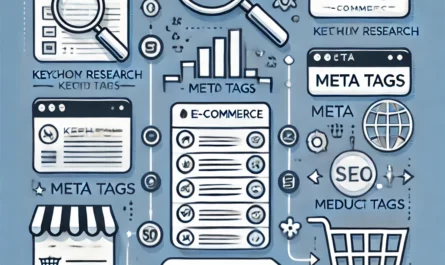Achieving high search engine rankings can be the key to unlocking massive amounts of organic traffic for your website. While SEO involves a variety of techniques, on-page optimization is one of the most crucial areas to focus on. But what exactly is on-page SEO, and how can it help you improve your rankings? This guide will take a deep dive into the key strategies for on-page optimization, revealing how they can significantly improve your visibility on search engines like Google.
What Is On-Page SEO?
On-page SEO refers to the optimization of individual web pages to rank higher and earn more relevant traffic in search engines. This involves tweaking elements like content, HTML source code, and user experience components. Essentially, it includes anything you can control on your website to improve its performance in search results. Unlike off-page SEO, which involves factors like backlinks and social signals, on-page SEO is all about what you can change internally on your site.
Why On-Page Optimization Matters for SEO
On-page SEO plays a critical role in ensuring that search engines like Google can efficiently crawl and understand your content. The more optimized your page is, the better search engines can interpret it, improving the likelihood of ranking higher. Moreover, on-page SEO impacts user experience, which has become an important ranking factor in recent years. By improving various aspects of on-page SEO, you not only make your content more digestible for search engines but also provide a better experience for your visitors.
Key Factors for SEO Success
Understanding what factors contribute to better SEO rankings is essential before diving into the specifics. The major components of on-page SEO include:
- Content quality: Is your content informative, relevant, and engaging?
- Keywords: Are the keywords relevant to your audience, and are they strategically placed?
- Meta descriptions: Do they summarize the content effectively and entice users to click?
- Internal linking: Are you guiding users and search engines through your content with proper links?
These are just some of the elements that can affect your website’s ranking and visibility. Let’s now look deeper into these factors and how they can help improve your SEO rankings.
Optimizing Title Tags and Meta Descriptions
Crafting Click-Worthy Titles
Your title tag is one of the first things that both search engines and users see when they land on your page. A well-optimized title tag should include your primary keyword, be under 60 characters, and convey a clear message. For instance, if you’re targeting “on-page optimization,” a great title could be “Master On-Page Optimization for Better SEO Rankings.”
Using power words or emotional triggers can further improve click-through rates. The goal here is to write a title that not only contains your main keyword but also grabs attention.
Writing Effective Meta Descriptions for SEO
The meta description is a short snippet of text that appears beneath your title in search engine results. While it may not directly affect rankings, it plays a huge role in getting users to click on your link. Meta descriptions should be clear, concise, and under 160 characters. Including a call-to-action (CTA) such as “Learn more” or “Get started” can motivate users to visit your page.
Using Headers and Subheaders Effectively
Importance of H1, H2, and H3 Tags
Headings and subheadings (H1, H2, H3, etc.) help structure your content in a way that’s easy for both users and search engines to navigate. The H1 tag should generally include your main keyword and accurately describe the content of the page. H2 and H3 tags are used for breaking down the content into more digestible sections.
Not only do these tags improve readability, but they also provide search engines with a clearer understanding of the content hierarchy, boosting your chances of ranking higher.
Structuring Content for SEO Rankings
Using headers and subheaders strategically can enhance user experience and keep visitors engaged on your page longer. This, in turn, signals to search engines that your content is valuable, which can improve your ranking. Make sure to use keywords naturally in your headers, but avoid keyword stuffing. Keep the user experience in mind while structuring the page, as search engines reward user-friendly content.
Keyword Optimization Techniques
Identifying High-Performing Keywords
Before you can optimize your content, you need to identify the right keywords to target. Start by conducting keyword research using tools like Google Keyword Planner, Ahrefs, or SEMrush. Look for keywords that have a good balance between search volume and competition. Long-tail keywords, which are longer and more specific, often have lower competition and can bring more targeted traffic.
Strategic Keyword Placement
Once you’ve identified your target keywords, it’s important to place them strategically within your content. Key areas to focus on include:
- Title tags
- Meta descriptions
- Header tags (H1, H2, etc.)
- The first 100 words of your content
- URL slugs
- Image alt text
However, be sure to use keywords naturally. Overusing keywords can result in keyword stuffing, which can hurt your SEO performance.
Avoiding Keyword Stuffing
Keyword stuffing is the practice of cramming as many keywords into your content as possible, and it can lead to penalties from search engines. Instead, focus on creating high-quality, engaging content that naturally incorporates keywords. Your primary goal should always be to create value for your readers rather than just appeasing search engines.
Improving URL Structure for SEO
SEO-Friendly URLs Explained
Your URL structure plays a surprisingly important role in SEO rankings. Ideally, URLs should be short, descriptive, and include your target keyword. Search engines favor clean, readable URLs, and they are also more likely to be clicked by users.
Best Practices for URL Optimization
When creating URLs, aim for simplicity. A URL like www.example.com/on-page-seo-tips is far more effective than www.example.com/pageid123456. Use hyphens to separate words and avoid using unnecessary characters or numbers. Including your primary keyword in the URL can give you a slight SEO boost and improve user experience.
Content Quality and Relevance
Writing Engaging, Valuable Content
At the core of any successful SEO strategy is high-quality content. Google’s algorithms are increasingly focused on providing users with the most relevant and valuable content for their queries. Ensure that your content answers questions, solves problems, or provides insights that your target audience is looking for.
Additionally, long-form content (over 1,000 words) tends to perform better in search rankings. However, length alone isn’t enough—your content must be well-structured, comprehensive, and easy to read.
You Can Also Read : How to Execute a Competitive Pricing Strategy for Business Growth
Ensuring Content Matches Search Intent
Matching content to search intent means understanding what users are looking for when they search for your target keywords. For example, if someone searches “how to improve SEO rankings,” they are likely looking for actionable tips and strategies. Align your content with the user’s intent, whether it’s informational, navigational, or transactional.



